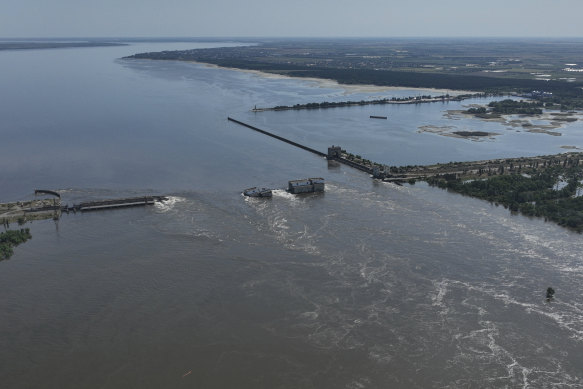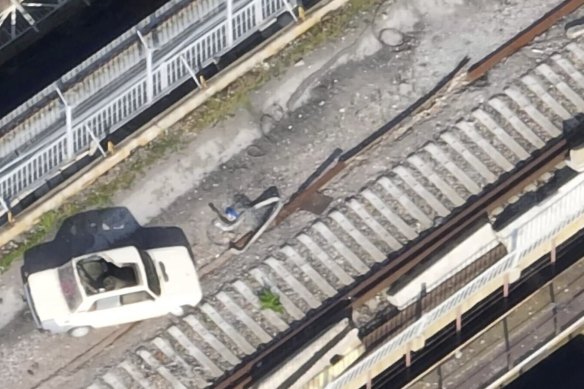
In recent weeks, Ukraine’s armed forces have reported limited gains in the beginnings of a counteroffensive to take back territory seized by the Russians since their invasion in February 2022.
Russian President Vladimir Putin himself indirectly acknowledged the advantage to his forces last week, although he maintained Russia’s denials of responsibility: “This may sound weird, but nonetheless. Unfortunately, this disrupted their counteroffensive in that area.”

Water flows over the collapsed Kakhovka Dam in Nova Kakhovka, in Russian-occupied Ukraine.Credit: AP
Speaking before a meeting of military correspondents, he explained his use of the word “unfortunately” with bravado: “It would have been better if they had attacked there,” he said.
“Better for us, because it would have ended very badly for them, attacking there.”
Kakhovka is one of a series of Soviet-era dams along the Dnipro (or Dnieper) River that were built to withstand enormous force, amounting to thousands of pounds of explosives. They were constructed in the wake of the infamous World War II “Dambusters” raids by the British that destroyed German dams. Taking out the Moehne dam in 1943, for instance, required five 4½-ton, specially made “bouncing bombs”, according to the Imperial War Museum archives.
Loading
Ukraine is not believed to possess any single missile with that kind of power.
Sidharth Kaushal, a researcher with the London-based Royal United Services Institute, said the Ukrainians are not believed to have any missiles with a payload greater than about 500 kilograms.
Nor does it seem credible that Ukrainian commandos could have sneaked in thousands of pounds of explosives to blow the dam, which was completely controlled inside and out by Russian soldiers for months.
As recently as the day before the structure’s June 6 collapse, Russians had set up a firing position inside the dam’s crucial machine room, where Ukrhydroenergo, the agency that runs the dam system, said the explosion originated. Ukrainian President Volodymyr Zelensky said as early as October 2022 that the dam was mined.
Zelinskyi, who is not related to the Ukrainian president, confirmed that the explosion seemed to come from the area where the machine room is located. He and an American official familiar with the intelligence both confirmed that Russian forces had been ensconced there for some time. The American spoke on condition of anonymity to discuss sensitive material.
The Institute for the Study of War, an American think tank that has monitored Russian actions in Ukraine since the war began, has assessed that “the balance of evidence, reasoning, and rhetoric suggests that the Russians deliberately damaged the dam”.
In the days leading up to the single explosion, Ukrainian military drone videos showed dozens of Russian soldiers encamped on a bank of the Dnipro, relaxed as they walked back and forth to the dam with no cover — suggesting their confidence in their control of the area and especially the dam, which was strategically crucial.
The photos, taken from Ukrainian drone footage, obtained by the AP and dated May 28, showed a car parked on the dam, its roof neatly cut open to reveal enormous barrels, one with what appears to be a land mine attached to the lid and a cable running toward the Russian-held side of the river. It’s not clear how long the car remained.

A car on the Kakhovka Dam that appears to be laden with explosives. Credit: AP
A Ukrainian special forces communications official, who also noted the car appeared to be rigged, said he believed the purpose of that was twofold: to stop any Ukrainian advance on the dam and to amplify the planned explosion originating in the machine room and destroy the top of the dam. The car bomb itself would not have been enough to bring down the dam. The official spoke on condition of anonymity to preserve operational secrecy.
Loading
The explosion detected at 2.54am local time registered on Norwegian seismic monitors at nearly magnitude 2. By comparison, a catastrophic explosion at Beirut’s port that killed scores of people and caused widespread destruction registered at a 3.3 on the seismic scale and involved at least 500 tons of explosives.
“That means it’s a significant explosion,” said Anne Stroemmen Lycke, CEO of the Norwegian earthquake monitoring agency NORSAR.
Within a few minutes, water from the Kakhovka reservoir began cascading through the shattered dam, submerging the river’s sand bar islands and flooding much of southern Ukraine, including Russian-controlled territory.
Loading
Immediately after the dam’s collapse, some experts noted that the structure was in disrepair, which could have led to the breach. But the area most obviously in disrepair, a section of roadbed near the edge where Russian forces had detonated explosives to block a Ukrainian offensive last fall, was still intact days after most of the rest of the dam collapsed.
Ukraine’s intelligence service released an intercepted conversation it said was between a Russian soldier and someone else in which the soldier said “our sabotage groups were there. They wanted to create a scare with the dam. It didn’t quite go according to plan.”



























